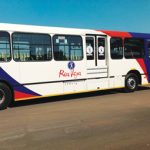Wellington trolleybuses come off the wires

FRANK BEETON reports on what could be considered the next generation of trolleybuses
Despite a widely held perception that they went out of fashion many years ago, trolleybuses still continue to pop up in various parts of the world, even in the British area of influence within which they were once so popular.
The operational disadvantages of being tied to, and dependent on, an overhead power supply have been well documented. Yet, trolleybuses still offer environmentally clean, silent and smooth operation as their main benefits, and some operators have chosen to live with the limitations in order to still provide their customers with those advantages.
One such operator is Infratil-owned NZ Bus, which is the largest operator of urban bus services in New Zealand, with a 1 000-strong fleet in the Auckland and Wellington areas.
The evolution of new driveline technologies has raised the possibility of maintaining the advantages of electric bus operation, while eliminating the operational limitations, and removing the unsightly overhead catenary power-supply infrastructure needed to support trolleybus services.
It was recently announced that NZ Bus had contracted Wrightspeed – a California-based manufacturer of range-extended electric-vehicle powertrains – to supply its Route 500 technology for a retrofit programme involving the 60-strong trolleybus fleet currently operating in Wellington.
The Wrightspeed hybrid “package” includes a multiple fuel-capable Fulcrum gas-turbine generator, on-board battery pack and individual geared-wheel traction motors – which will enable the trolleybuses to operate independently of any overhead power supply.
Readers will have noted that this concept’s basic features, and some of its claimed benefits, are remarkably similar to those of the Nikola One line-haul truck described in this month’s Global Focus on page 38.
However, the important difference between the two is that the first converted Wellington trolleybuses are scheduled to be back in regular service before the end of 2016, whereas the first Nikola One has yet to appear in tangible form.
Interestingly, NZ Bus has mentioned that the potential ability to deploy converted trolleybuses to other parts of New Zealand is an important benefit of this programme. Consideration will be given to converting other bus types to the Wrightspeed system once it has been fully evaluated under operational conditions, and found to be suitable for NZ’s rigorous road conditions.
In our view, this type of turbine/electric hybrid offers the advantages of clean operation without much of the technical complexity that goes with the various combinations of internal combustion engines, mechanical or fully automatic transmissions, in-line electric traction motors and live drive axles that have evolved over recent years.
The multifuel capability of the gas-turbine engine is also a massive benefit in countries, such as South Africa, that still lack an availability of clean fossil-derived fuel.
It is not clear whether there are any associated issues with the heat and noise generated by the gas turbine, but we understand that considerable experience has already been gathered with similar hybrids in waste-collection applications, which have many similarities to bus operation.
It is worth noting, however, that both of these turbine hybrid examples have been developed by concerns outside of the mainstream motor industry, and it will be interesting to see if any future support for this concept is eventually forthcoming from that quarter.
Published by
Focus on Transport
focusmagsa




